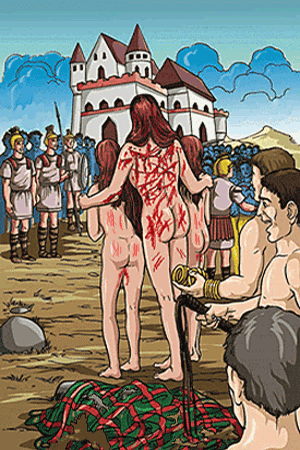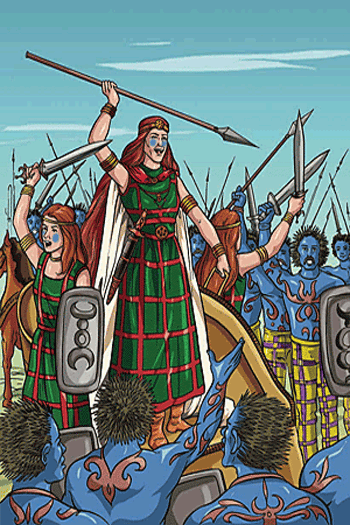English and Its Historical Development, Part 05
(The Warrior Queen of the Iceni, Boudicca, Bodicea, or Boadicea, meaning "Victory", defied and attacked the Romans with her Iceni warriors, and was the embodiment of a people's hatred of Roman mistreatment)
The Iceni tribe demonstrated their anger and hatred of the Romans
The Iceni had risen in battle against the Romans and were marching toward the unprotected cities of south-east Britain and other tribes had joined them.
The focus of resistance was the Iceni tribe, which had at first accepted Roman domination; although, from time to time they resisted it.
Tacitus, the Roman historian, admitted that the cause of their resentment was exploitation, from which their neighbors, the Trinovantes, also suffered.
Tacitus was the most important Roman historian of this period and took a particular interest in Britain as Gnaeus Julius Agricola, his father-in-law and the subject of his first book, served there three times. Agricola was a military tribune under Suetonius Paulinus, which almost certainly gave Tacitus an eyewitness source for Boudicca's revolt.
When the Icenian King, Prasutagus, died, he made the Emperor Nero co-heir to his realm with his own two daughters. With this procedure, he hoped to preserve his kingdom and household for his family; but his efforts did not work.
"Kingdom and household", wrote Tacitus "were plundered like prizes of war, the one by Roman officers, the other by Roman slaves. The Icenian chiefs were deprived of their hereditary estates as if the Romans had been given the whole country. The King's own relatives were treated like slaves."
As it was considered illegal for a client King to not will his entire estate to the Emperor (from a Roman perspective) Decianus and his legionaries were completely within their right to exact payment in full.
According to Tacitus: "His (King Prasutagus) dominions were ravaged by the centurions; the slaves pillaged his house, and his effects were seized as lawful plunder.
His wife, Boudicca, was disgraced with cruel stripes from a whip; her daughters were ravished (raped), and the most illustrious of the Icenians were, by force, deprived of the positions which had been transmitted to them by their ancestors.
The whole country was considered as a legacy bequeathed to the plunderers. The relatives of the deceased king were reduced to slavery."
The invading Romans had come to Britain, supposedly as bearers of a superior culture; yet, their soldiers had behaved abominably, treating the natives like slaves.
Greedy tax-collectors had exacted heavy tributes. The Procurator (imperial agent), Catus Decianus, was notoriously acquisitive, and he was bleeding the inhabitants for everything he could take. "It was his rapacity," writes Tacitus, "which had driven the province to war."
Tacitus wrote that the Warrior Queen, Boudicca, was flogged and her daughters raped.

When the Roman officials came to strip Boudicca of her governing rights, her dignity, and any personal property of value; these Romans misjudged what such humiliations would cost them.
They must have assumed the Icenian queens' righteous anger could be controlled by the whip while her daughters could be conveniently deflowered, or robbed of their virginity, and so made less desirable for marriage to any noblemen of the tribe and that these women could do nothing about it.
Anticipating that Boudicca might have quietly been subdued after such treatment was not about to happen. While she might not have cared about her own situation, she had her daughters to fight for.
Rome had previously abused the sovereignty of Britain; now it had ravished, or sexually abused, the daughters of an Icenian king, young women who were of the royal king's bloodline.
Someone has suggested that the Romans, for their own benefit, would have done better to kill all three women. If the queen and her daughters were slain, a directionless battle by Boadicca's warriors might have resulted: one which would have been easily won by the Romans.
As it turned out, the Iceni rose to the urgings and commands of an outraged mother, and queen, resulting in a far greater degree of destruction and slaughter than would otherwise have occurred.
The Icenian queen was ready to tear apart those who had harmed her offspring

A Roman writer named Dio Cassius presented a description of Boudicca
"In stature, she was very tall, in appearance most terrifying, in the glance of her eye, most fierce, and her voice was harsh; a great mass of the tawniest hair fell to her hips; around her neck was a large golden necklace; and she wore a tunic of various colors over which a thick mantle was fastened with a brooch. This was her invariable attire."
It was said that the women of the Iceni tribe were as tall and also as fierce as their men, and would also follow them into battle; armed with swords and axes which they would use on their opponents as they screamed hideously.
It was the year A.D. 60-61 and at the head of the Iceni tribe stood a flame-haired woman who was, as stated previously, the widow of King Prasutagus of the Iceni. She stood proud and erect, shoulders back despite the discomfort of the lash marks left on her body. Whip marks which she received at a public beating at the hands of the Romans.
Again, as described before, at her side stood her two teenage daughters whose treatment at the hands of Romans was no less outrageous than their mother's, having been raped repeatedly by Roman soldiers and/or slaves because their father had attempted, in his will, to have them inherit a portion of his estate upon his death.
Boudicca and her daughters drove round in her chariot to all her tribes before the battle, exhorting them to be brave. She cried that she was descended from mighty men, but she was fighting as an ordinary person for her lost freedom, her bruised body, and outraged daughters.
Perhaps as a taunt to the men in her ranks, it is said that she asked them to consider: "Win the battle or perish: that is what I, a woman will do; you men can live on in slavery if that's what you want."
Boudicca and her Iceni followers showed no mercy to those who were affiliated with the Romans
Boudicca incited her people to avenge her family's outrage and to throw off the chains of Roman rule. It is estimated that she led over one hundred thousand men and women into battle.
First, she marched on Colchester (Camulodunum) burning the temple dedicated to Claudius the Roman Emperor, followed by London (Londinium), which she razed to the ground, then on northwest to St. Albans (Verulamium), which met a similar fate.
Wherever they went, the Iceni burned and pillaged. They took no hostages and captives were subjected to every known barbaric outrage.
Women were said to have been disfigured and then impaled on sticks and it is said that Boudicca made many a human sacrifice to the Celtic Goddess Andrasta.
Boudicca's barbaric deeds paralyzed the British countryside with fear. Divisions of soldiers were sent by Rome against her army but all were defeated.
So the Romans called in Gaius Suetonius Paullinus, the Roman military governor of Britain, who with only an army of ten thousand warriors went to meet Boudicca and her Inceni warriors.
At the final battle we would see Boudicca fully armed standing in her chariot with her daughters by her sides.
She was clothed, unlike many of her followers who would go into battle naked with their skin painted blue with woad and often with tatoos. Woad was a yellow-flowered European plant of the cabbage family and it was formerly widely grown in Britain as a source of blue dye, which was extracted from the leaves after they had been dried, powdered, and fermented.
Boudicca was in her clan tartan and fully armed. Although she must have been tired and had sustained an injury, her appearance was still both inspiring and terrifying to her enemies.
Although the Romans were greatly outnumbered, they destroyed the Iceni forces
The Roman soldiers were outnumbered but Gaius Suetonius Paulinus, a clever tactician chose to attack Boudicca in what may have been a narrow valley and so he had the advantage over greater numbers of opposing forces.
Seeking a favorable position, Paulinus organized his men on the site which gave him good protection to his flanks, and in their excess of confidence, the advancing rebels blocked their line of retreat with their own wagons occupied by their wives and children.
Here was a situation in which superior discipline and heavier body armament made up for any disadvantages which the Romans suffered from with their inferiority in numbers.
With javelins and infantry, the Romans advanced slaughtering not only the Iceni warriors; but, as stated earlier, also, their families who were waiting behind them unarmed and defenseless. It was a massacre with an unconfirmed stated number of "over eighty thousand Inceni slaughtered".
Boudica is said to have survived the final battle and managed to escape. She is believed to have decided to take poison rather than be subjected to the humiliation of being paraded by the Romans in their triumphal processions; after which, she would probably have been condemned to the gladiatorial arena to finish her days as a public spectacle, before being killed by sword or animals.
Boudicca, or Boudicea, has secured a special place of her own in British folk history remembered for her courage
The Warrior Queen, who fought the might of Rome may indeed have received some recognition of her revenge objectives, because in 1902, a bronze statue of her riding high in her chariot, designed by Thomas Thorneycroft, was placed on the Thames embankment next to the Houses of Parliament in the old Roman capital of Britain, Londinium; now known as London.

The great bronze statue of Boudicca was commissioned by Prince Albert (husband and consort of Queen Victoria of the United Kingdom, 1819-1861). It presents Boudicca in her war chariot (shown with scythes in the Persian fashion), together with her two daughters.
The plinth (stone-block structure) upon which this statue rests is engraved with the words:
Who died A.D. 61 after leading her people against the Roman invader.
Queen of the Iceni and her name
For many years she was called Bunduica, then she became Bonducca and even later, Boudicca, Boudica, or Boadicea. Regardless of which spelling was used, her name, derived from the Celtic word bouda, which is said to mean "victory" or "victorious".
The early spellings are said to have resulted from poor medieval manuscript transcriptions and an inaccurate Elizabethan version of Tacitus, whose account of her story was unknown until the sixteenth century.
The name is attested in inscriptions as "Boudica" in Lusitania, "Boudiga" in Bordeaux, and "Bodicca" in Britain.
Based on the later development of Welsh and Irish, Kenneth Jackson (English linguist and a translator who specialized in the Brythonic languages) concludes that the correct spelling of the name is Boudicca, pronounced BOU di kuh; although it is mispronounced by many as BOO di kuh.
Following the changes of her name are far more easy to do than getting accurate information about her life. Supposedly much is known about the military details of the revolt of 61 A.D.; her end; and something about her motivations for challenging the Romans.
Although her name is well known in British history, there is very little of anything else which is known about her besides that which has been revealed in this page.
For more information, see this Boadiccea's, or Booudicca's, Background.
Part 6, Hadrian's wall to protect the Romans in the south from Picts in the north.
INDEX or Table of Contents, English and its historical development.
References: sources of information.
